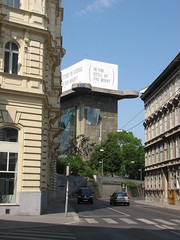Going Bezirk in Wien
Snapshots of the neighborhoods of Vienna and the History that Formed its culture
19 November 2010
The World fo the Hapsburgs
Intrigued by the Austrian Royal family? Check out: http://www.habsburger.net/
20 October 2010
Mariahilf

"If you live in Vienna, you are affiliated with the district that you live at in a similar manner as tribal societies are associated with a clan - you feel a cold breeze and hateful stares every time you cross the border to another district. When I lived in Vienna, the sixth district or Mariahilf was my home for a quite a while and in a way, I still feel like I have the duty to defend Mariahilf and portray it as being particularly cool. Just that you are warned and not disappointed to find out that Mariahilf might be not that great after all.” -- Long time Mariahilf resident (from http://www.tourmycountry.com/austria/sixth-district-vienna.htm)
Mariahilf is Vienna’s 6th district. Its western border is outlined by the Gürtel, a red light area in Vienna. The southern border is the Naschmarkt with amazing food stalls of domestic and exotic fruits, vegetables and spices. The northern border is the Mariahilferstraße, a continuous shopping area where you can shop at larger international brands. The eastern borer is the Lastenstraße, which was built mostly for deliveries for the palaces of the Ringstraße and the Academy of Fine Arts.
History:
First settlements around the Roman roads of the area developed around the year 1000. In 1428, a copy of a sacral painting from Passau was installed in a chapel which came to be known as Mariahilf ("Mary's help"). More settlement started after the Second Turkish Siege of Vienna in 1683. The area was of some importance because the road to imperial Schönbrunn Palace went through it.
The old neighborhoods represented in the district crest include: Gumpendorf which was developed from a Roman watchtower. It was subject to various feudal lords and was sold to the municipality of Vienna in 1798. Magdalenengrund consisted only of vineyards until 1698 when some plots were released for construction. The Laimgrube (clay pit) is probably the oldest part of Mariahilf and existed since the 11th century. Its name is derived from the clay soil, which produced bricks. Windmühle (windmill) developed from a feudal holding used by various monastic orders that was destroyed during the First Turkish Siege. On March 6, 1850, the five Vorstädte of Gumpendorf, Mariahilf, Windmühle, Magdalenengrund and Laimgrube became part of Vienna as the Fifth District, Mariahilf. When Wieden was split into two districts in 1861, it became the 6th District. Towards the end of the 19th century, Mariahilf had developed to become an important business district of Vienna.
What's there?
Naschmarkt & Theatre Scene of Mariahilf:
The Academy is responsible for the arty atmosphere of the eastern corner of Mariahilf. Here you find many small galleries, art shops, and professional interior design and designer furniture shops. Just by the Wienzeile across from the the Naschmarkt is the Theater an der Wien. In the 18th century, it was a suburban theater of dubious reputation, run by a freemason Emmanuel Schikaneder. Together with his drinking buddy and loge brother Wolfgang Amadeus Mozart, he produced an opera called "Die Zauberflöte" (The Magic Flute), which was first performed in the Theater an der Wien. This did not prevent the people in charge with the Theater to transform its sacred halls into a musical stage until a few years ago. The area is also very popular for gay culture in Vienna and includes a gay community center.
 Wienzeile & Haus des Meeres Aquarium:
Wienzeile & Haus des Meeres Aquarium:On the Wienzeile, are two of the most famous buildings in Mariahilf: The Wienzeilenhaus and the Majolikahaus, both designs in Jugendstil by Otto Wagner. If you turn right toward the central part of Mariahilf, this area is dominated by a massive concrete Flak tower - built by the Nazis do defend Vienna during WWII. It is now used as a private zoo and aquarium called the Haus des Meeres.
Also in this area is The Barnabitenkirche or Mariahilfer Church is a baroque church of pilgrimage and worth a closer look. The memorial for Joseph Haydn in front of the church commemorates the "father" of the Viennese Classic who lived and died in Mariahilf. Right next to the concrete tower, you can find the Apollo movie theatre, remarkable for its Art Deco façade; inside there is a standard multi-screen cinema.
The area further west is mostly residential, but is full with small shops, restaurants and a few backyard stage theatres. IN the west there is also the Raimund theatre, though, named after the playwright and actor Ferdinand Raimund which is now Vienna′s premier musical stage.
Subscribe to:
Posts (Atom)